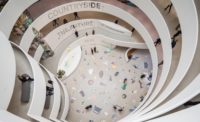In Situ: George Ranalli Works & Projects, by George Ranalli. Oscar Riera Ojeda Publishers, September 2014, 496 pages, $75.
Public Natures: Evolutionary Infrastructures, by Weiss/Manfredi. Princeton Architectural Press, September 2015, 376 pages, $50.
Learning Through Practice, by Rob Rogers. ORO Editions, February 2015, 220 pages, $40.
Reveal, Filter, Evolve, Effect (Core), by FXFOWLE and Liz Campbell Kelly. ORO Editions, September 2014, 320 pages, $40.
Improvisations on the Land: Houses of Fernau + Hartman, by Richard Fernau, Laura Hartman, Thomas Fisher, and Daniel Gregory. Monacelli Press, October 2015, 182 pages, $46.
At a time when bookstores are a nostalgic throwback to the past, and Rizzoli, known so well for its architectural monographs, has just published Kim Kardashian West: Selfish, these six serious tomes present a brave face to the future. Nevertheless, architects seem to resist letting go of the monograph, the encapsulation of their careers that distills the best of their work. The great models are Palladio’s Quatri Libri, Schinkel’s Sammlung Architektonischer Entwurf, Aalto’s Complete Works, and, of course, Le Corbusier’s magisterial eight-volume Oeuvre Complete.
In recent years, monographs have become the Birkin bags of architecture—a “must have” accessory for every ambitious practitioner and a valuable marketing tool that can cost as much as $100,000 for the architect to produce. The subject of the monograph must pay for photography or rights to publish photographs, the cost of writers to create the essays, and also commit to purchasing a certain number of books in advance, not to mention forking over money to interns who redraw the plans, build models, and produce renderings. But websites are challenging books as efficient marketing tools, and publishers are finding that monographs don’t make much money. Hence we see the growth of a new breed: the camouflaged monograph—which seems at first glance to be about larger questions facing architecture culture rather than strictly a survey of a particular architect. Whereas titles used to be simple—the multivolume Richard Meier Architect, for example—they now arrive with a theoretical promise.
Still, the five architectural firms behind the books here have produced beautiful artifacts for the public, friends, clients, and admirers, each completely different in its approach and presentation. By far the most lavish and precious is In Situ: George Ranalli Works & Projects, which comes in a heavy slipcase. Drenched in deep-red, sensually slippery paper, the box opens to reveal, like a medieval illuminated manuscript, the totality of Ranalli’s dedication to detail and materiality, a gesamtkunstwerk-type of career that ranges from hardware to master plans. Among my favorites are the extraordinary Saratoga Avenue Community Center in Brooklyn (2008) and the Atelier International Table Design (1993). Too bad more of Ranalli’s work has not been built.
The title of Weiss/Manfredi’s monograph, Public Natures: Evolutionary Infrastructures, is a fancy way of saying how old highways, overpasses, train tunnels, and industrial waterfronts can be transformed into wonderful public parks and gathering places. The work is quite spectacular, even if about 50 percent of what’s covered is not infrastructure at all but devoted to brilliant educational and institutional buildings such as the Nanotechnology Center at the University of Pennsylvania in Philadelphia (2013) or the Novartis Headquarters in East Hanover, New Jersey (2013). Half of the book presents the firm’s projects. The rest offers running commentaries on themes found in the work and is, at times, confusing, with long quotes by dead critics and architects such as Le Corbusier, Reyner Banham, and Colin Rowe.
Rob Rogers’s Learning Through Practice seems at first to be the work of a young up-and-coming architect, since there is not much built work but lots of luminous renderings. Nary a hint is given about the previous long, productive partnership Rogers had with Jonathan Marvel. The enthusiasm and clarity of the new public projects is infectious, however, and bodes well for the future.
FXFOWLE’s series of four pamphlets in a box—Reveal, Filter, Evolve, Effect sound like instructions for a newfangled washing machine—is less effective because its unnecessary informality obfuscates the firm’s formidable and varied global projects. These throwaway pamphlets don’t do justice to FXFOWLE’s work.
Improvisations on the Land: Houses of Fernau + Hartman seems straightforward enough: the 18 houses by this San Francisco Bay–area firm are charming, playful riffs on vernacular barns and sheds, via Charles Moore’s Sea Ranch, Frank Gehry’s Venice Beach lifeguard house, and John Hejduk’s animated figural works.
Carefully set in the landscape, they seem to have always been there. At times, though, the baroque efflorescence of sheds and gables devolves into a cartoon of a farmyard, and the later high-budget projects suffer from a self-awareness that muffles the exuberant invention of the earlier buildings.
All in all, this is a worthy harvest of architectural monographs for your collection, cleverly concealed behind catchy titles and promises of profound contemplation. If I ever attempt another monograph of my firm’s work, I am convinced it has to be based on the Book of Kells, with essays by Paul Auster, Pharrell Williams, and Fat Joe.











Post a comment to this article
Report Abusive Comment